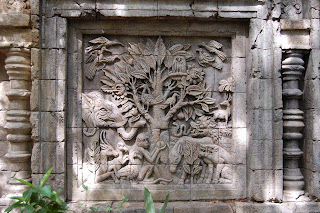While Asia at Disney's Animal Kingdom may have only opened in 1999, the history of the Kingdom of Anandapur goes back centuries. Some of this history is evident on the walls of the Maharajah's Hunting Palace, in portraits of several of Anandapur's early kings (or rajahs). Follow the portraits, and you'll see they tell a tale of the people and their transition from a mindset of controlling nature to one of coexisting.
The first rajah (above) is King Bhima Disampati, who initially closed the forest as a private hunting ground and commissioned the construction of the Hunting Palace. He's depicted with a bow and arrow. Nearby, birds flee and blackbuck antelope cower in the bushes. There are also a pair of cheetahs in this portrait, but notice they're wearing collars. Today, cheetahs are found almost exclusively in Africa, but they once covered a wider range where aristocrats often acquired them for use in hunting.
The first rajah was succeeded by his brother, who was lazy and didn't care for hunting. He had an appreciation for nature, but still in a very controlling sort of way. This king built the palace ballroom and created the pleasure gardens on the grounds. He is standing alongside one of his gardens (the ruins of which can be found nearby), holding a plucked flower and a string of pearls. He's also shown wearing a headdress adorned with exotic bird feathers.
Later in Anandapur's history, a new dynasty of rulers came along, bringing with it a period of peace (indicated by the pair of doves in this next portrait, above). This is the rajah who built the Red Temple, the model for which he holds in his hands. He may have had a certain reverence for nature, but his push for development often put him at odds with that. Note that he's standing on a bed of fallen palm fronds, indicating that portion of the jungle cut down to build the temple and expand the village.
Finally, we come to a portrait of a later rajah, who actually stepped down from his post and went to live out his life among the forest creatures. He's depicted in calm meditation, surrounded by birds who accept him as a friendly presence. It was he who turned the Royal Forest over to the people of Anandapur in the 1940s, so everyone might gain an appreciation for the region's natural treasures.















































